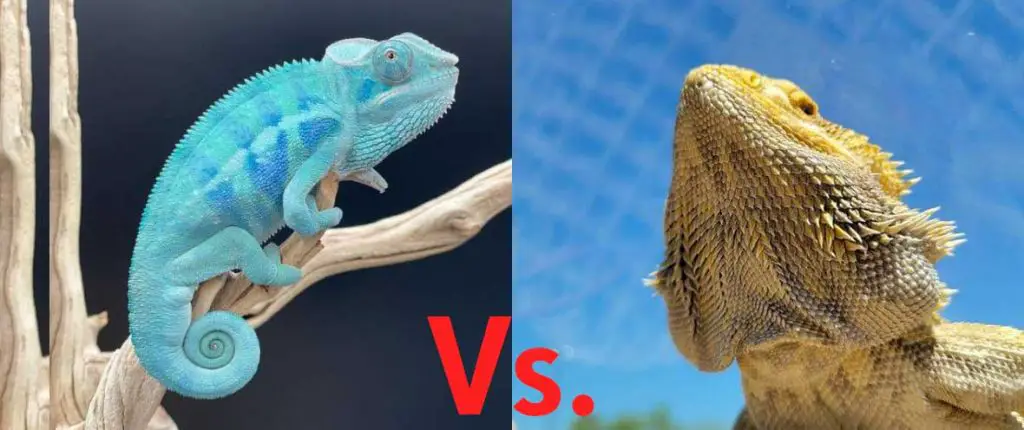What is the difference between a bearded dragon VS chameleon?
Bearded dragons and chameleons together are both very popular and pleasant reptiles to raise like a pet.
If you’re intending to adopt a lizard as a new member of your family, I would recommend a bearded dragon or chameleon.
But there are a few things you must keep in mind before adopting one because they are not the same.
“Ideas are easy, implementation is hard,” said Guy Kawasaki.
In the current writing, this means you can have the idea of owning bearded dragons or chameleons, which is easy.
However, raising them properly such as what to feed them and what’s the most suitable temperature for reptiles to live in is hard.
Needless to say, owning them requires a different living environment as the cost.
Consequently, we will have to do some homework for the best preparation. Luckily, an independent study has been done and will be shared in the following text.
So, shall we dig a little bit deeper about this? Let us discuss the differences between a bearded dragon VS chameleon.
Related Posts:
- How to Pick Up a Beardie?
- Why Does My Beardie Stare at Me?
- Can Bearded Dragons Eat Radish Greens?
- Why Is My Beardie Closing Eyes When Stroked?
- Can Bearded Dragons Eat Peas?
- Can Bearded Dragons Eat Honeydew Melon?
What Is a Bearded Dragon VS Chameleon?
As mentioned above, these two kinds of reptiles are different.
They are different in size, behavior, and diet, and each of them has very particular pros and cons.
So I have done some research and put down some comparisons of bearded dragon VS chameleon in a smackdown.
Just keep in mind that the following facts and knowledge is just a personal opinion.
I will try my best to deliver the most reliable information.
1. Bearded Dragons
The bearded dragon is a common name for Pogona, which is a genus of reptiles containing six types of lizard species.
The name refers to the underside of their throat, so some people call them “beardie.”
This beard can turn black and puff out for many reasons including when they are stressed or feel the threat.
a. Common Form
An adult bearded dragon can weigh from 250 to 300 grams and the lifespan can get up to 15 years.
This is because they can take from 8 to 18 months to be considered an adult.
Studies recommend feeding them with small crickets, mealworms, or vegetables such as carrots or squash.
b. Habitat
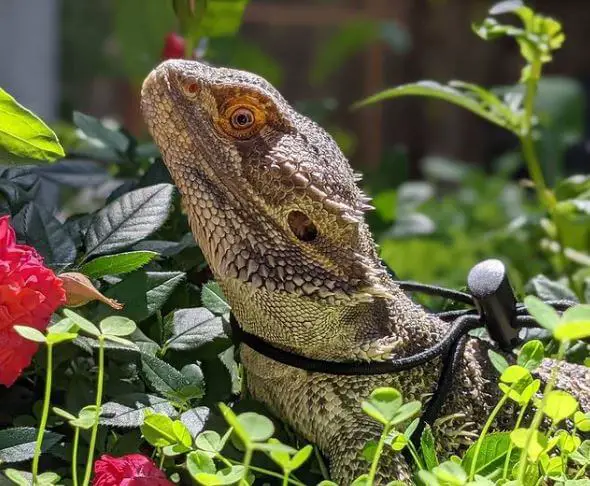
Beardies are originating from dry areas like deserts in Australia with many reptile species occupying slightly most of the landmass.
This means they can survive quite well in subtropical woodlands, scrublands, or shore areas.
Because they are semi-arboreal, they will be more likely to climb and bask at height.
This will lead to dominant acts/fights for basking areas or territory if they see another animal in their view.
c. Behavior
Talking about adult and fully-grown beardies are tending to be very territorial and aggressive.
As they grow, they will automatically set social hierarchies in which displays of aggression and appeasement as a part of their normal interaction.
An alpha or dominant male will adapt to a dominant position when they see another male.
This means they are always ready to fight for food sources, defend territory, or compete for a female.
This means if they see any male coming without showing them a submissive or friendly act, that male one will more likely be considered as a challenger or a threat by the alpha beardie.
Even the females can be attacked if they show no yielding acts in return.
Because the male beardie can offer a more powerful bite, the female will be more likely to suffer critical injuries.

In addition, beardies can notice illusions.
This means, according to an experiment at the University of Padova, “when you give them two dishes, a small dish and a bigger dish, and both contain the same amount of food, they will be more likely to choose the small dish because they know that a bigger dish does not mean it will contain more food.”
Sounds smart, right?
d. Reproduction
When we put bearded dragon VS chameleon together in terms of reproduction, bearded dragons are more aggressive in mating than chameleons.
When a male beardie finds a female mate, there will be a mating ritual where the male one starts to do his body language, including nodding his head and waving his arms, or stomping the legs in front of the female.
The male beardie will chase the female and bite her in the neck.
And then he will hold on there while he gets in the right position for mating.
In the breeding period, the female beardie will store the sperms in her oviductal crypts.
This means they can lay 10-30 eggs twice from just a single mating.

One more thing, the temperature in the breeding period can affect the gender of the young beardies in the eggs.
This means if the environment temperature is too high, it will reverse the gender of the young beardie.
Say the one in the egg is a male, but he will more likely breathe his first air as a female while still having a male reproduction part.
So please do not let their environment temperature get higher than 31 degree Celsius.
2. Chameleons
In case you are wondering something like, “Should I get a bearded dragon or a chameleon?” then you should take a look at the following facts.
Chameleons are super popular reptile pets, mainly because they can change their skin color.
About the original, they originated and were mostly imported from African countries like Madagascar or Togo.
Most trading species are veiled chameleons, Senegal chameleons, and panther chameleons.
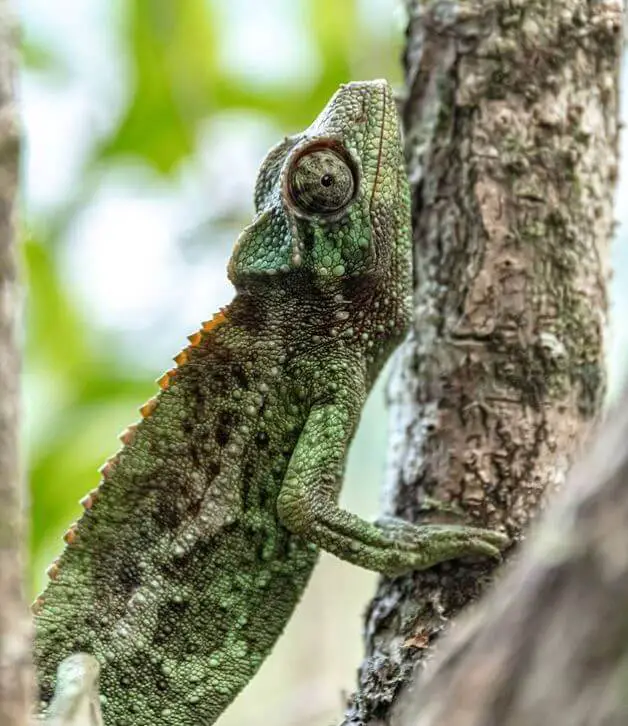
a. Common Form
Unlike beardies, a chameleon takes 6 or 7 months to be fully grown.
An adult chameleon can weigh from 300 grams to 500 grams and the lifespan is at 2 to 5 years.
The only thing similar between them is the diet. They both eat crickets, mealworms, and vegetables or leaves.
Chameleons usually sip water directly from a leaf, so you should give them something similar.
b. Habitat
Chameleons mostly live somewhere in the rainforest and deserts of Africa.
Because of that, their skin can adapt to the environment and change color so they can hide from predators.
The skin color also represents their living habitat.
For example, a green skin chameleon means they tend to hang out in the trees.
Just like that, a brown chameleon usually lives in deserts.
The skin color also helps them in warming up or cooling down their body heat.
Turning their skin darker will more likely warm them because darker colors will absorb more heat or the opposite.
They also use their skin color to communicate with others or to attract mates.

c. Behavior
In terms of behavior, chameleons in wildlife do not hold a high place in the food chain.
This means they are usually consumed like food for other animals such as eagles, snakes, and pythons.
When facing these kinds of enemies, they can’t get away, so they will rely on their skin-changing ability.
Furthermore, chameleons will change their skin color if they notice any threat.
They can also change the pattern on their skin as a passive defense so they can hide from predators.
In case they have nowhere to hide, they will flatten their body to have a larger appearance.
To warn their enemy, they will open their mouth and use vocalization to threaten the enemies.
And if needed, they will utilize their feet and jaws to fight back, which does not always work.
d. Reproduction
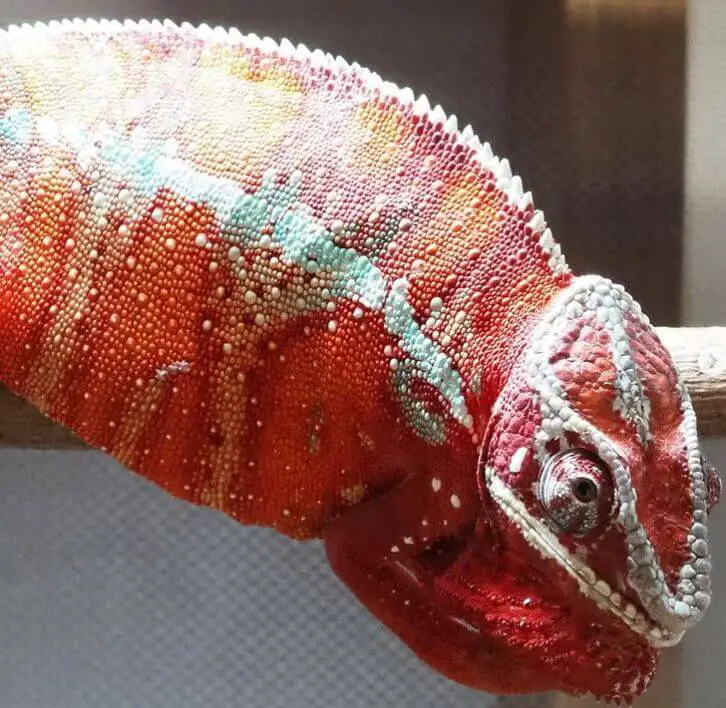
Unlike beardies, chameleons are way gentler in mating, which is kind of cute.
In the breeding period, the male one will show himself sideways to look larger. They will also rigid their legs and coil their tail.
They can stand out by nodding their head and approaching slowly because the female can bite them without warning.
The mating period can repeat over and over for three days.
And sadly, when it is successful, the female will start rejecting and leaving the male.
20 or 30 days after that, she will lay somewhere around 20 to 30 eggs in a small hole that she dug before.
Six months later, the well-developed baby chameleon will immediately leave the nest and will start hunting.
What Is the Difference Between a Bearded Dragon VS Chameleon?
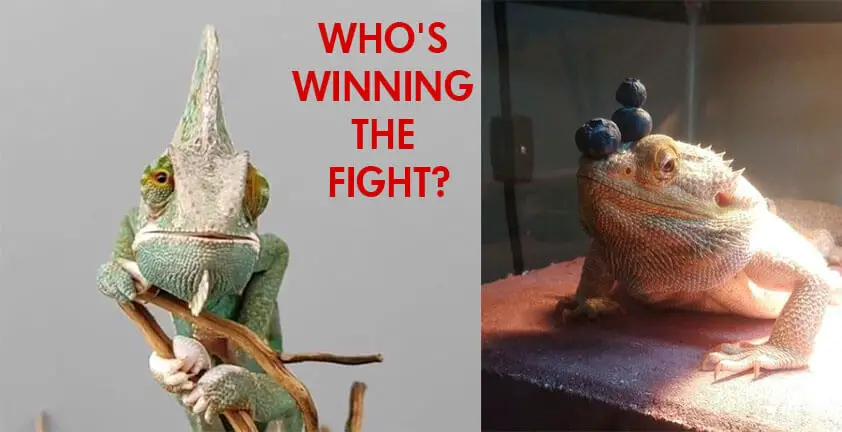
Since we have learned a bit about each type of species, it’s time to decide which one to own.
Each one will have their personal advantage and disadvantage. So, which one will suit you the most? Shall we find that out?
1. Size
The beardies can suit pretty much both adults and kids because they are easy to manage.
An adult beardie is just 20 to 26 inches long and weighs 400 to 500 grams.
Chameleons are most likely the same, but it will mostly depend on their sex.
An adult chameleon is just 10 to 25 inches long and weighs 400 grams.
2. Behavior
Beardies are just like dogs but in reptile forms, when they get familiar with you, they’re quite fun to watch.
You can hold them and they will show you their pleasure.
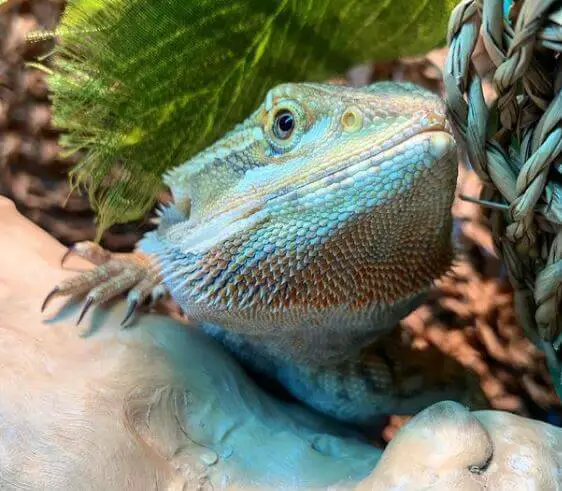
Unlike the beardies, chameleons are suitably aggressive and territorial. They are only nice with other chameleons.
They will not let you hold or pet them until they get super familiar with you, so they are the type of pet that prefers being watched to handheld.
3. Lifespan
With proper care and diet, a beardie can live up to 10 or 13 years. Unlike beardies, chameleons’ lifespan varies from 3 to 10 years for many reasons.
4. Diet
Beardies and chameleons are both omnivores reptiles, which means they will eat both smaller animals and plants.
Vegetables such as carrots or insects like worms will give them the protein they need.
5. Cage Setup

Both beardies and chameleons love climbing, so they will need a tank as their house.
An adult beardie will need at least a 75 gallons tank. You can always get a bigger one, not a smaller one.
This is similar to the chameleons as well.
What Diseases Are Common for a Bearded Dragon and Chameleon?
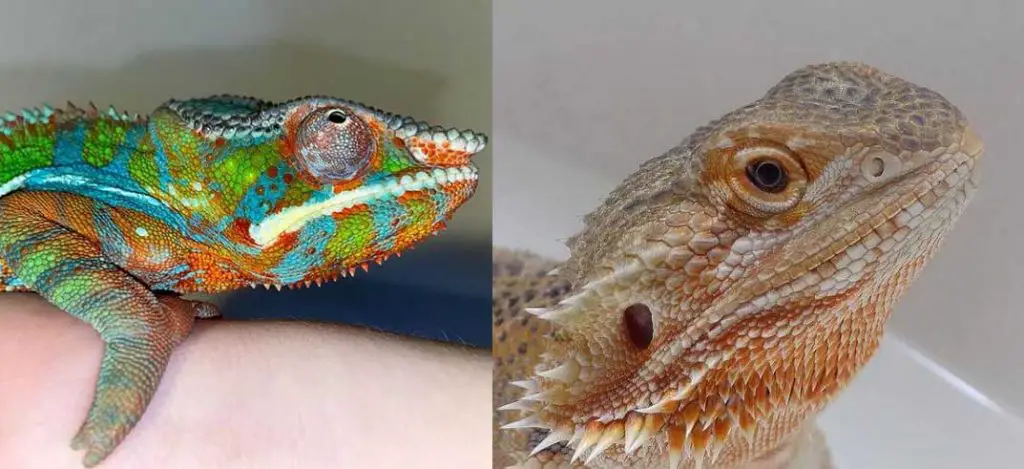
Just like every other pet, sometimes they will get some illness.
Some can be a hazard, some can cause your lizard a critical health issue, or even pass away.
So doing a bit of homework will help a lot in preventing the incoming risks.
Below is some common lizard disease that you should take note of before adopting one. Shall we begin?
1. Tail Loss
This can happen because of many reasons such as their tail being stuck in a branch or something similar.
Sometimes, it can happen during the fight for food sources or territory or females.
You can prevent this from happening by smoothening the sharp edges of the logs or something like that.
2. Thermal Burns
Your lizard can suffer from a thermal burn if they hang out at the wrong temperature for too long.
You have to carefully adjust their living environment temperature and pay lots of attention to them.
3. Lungs Issue
Just like humans, this can happen to your lizard if their air is polluted.
This lung issue can be critical and more likely to cost their life.
You can help them prevent this by paying attention to their living space.
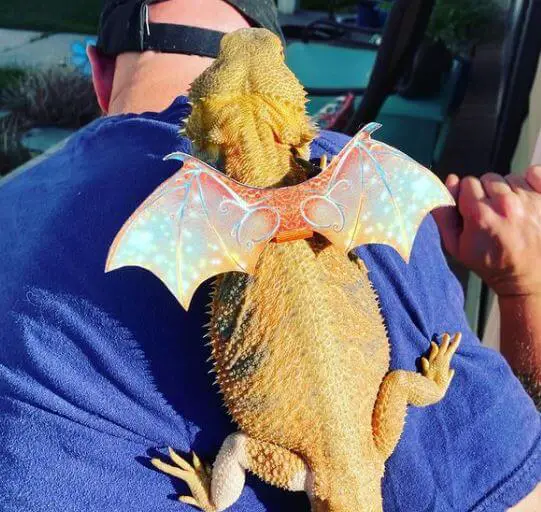
4. Bone Disease
This disease usually happens to lizards when they absorb the wrong Ca:P ratio in their diet.
To prevent this, you can properly study and adjust their diet, each species will have a different diet and food source.
5. Egg Binding
This only happens to female reptiles.
Egg binding means they can not lay their egg and will cause critical health issues or even threaten their lives.
So in the breeding period, only fully grown and healthy couples are allowed to mate.
This is because fully grown reptiles will more likely have the best condition for breeding.
Frequently Asked Questions About Bearded Dragon VS Chameleon
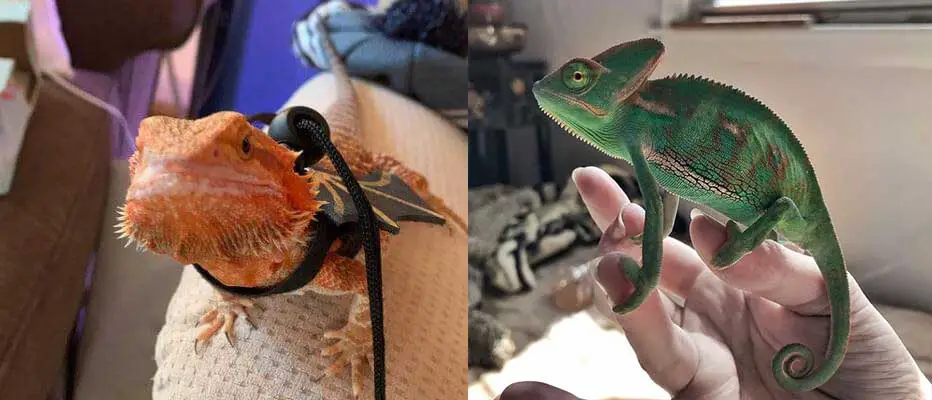
1. Which Is Better Between a Bearded Dragon VS Chameleon?
This will depend on what kind of personality you like. Do you want your pet to live a good life without spending all day looking after them?
I would highly recommend a bearded dragon. They can be tamed much easier when compared with chameleons.
They are more comfortable with people or other animals, as long as they feel no threat.
And also you can do many things with them.
On the other hand, chameleons are way more defensive and they do not like you to touch them.
This is because they are developed as food for bigger animals for a very long time.
2. What Is the Best Enclosure for a Bearded Dragon?
In case you are new to owning and growing a beardie, you will need a cage first.
There are dozens of cages being sold on the market, but which one is the best?
The tip is to forget things such as “starter cage” or “all in one cage.” Those are useless.
A beardie will need different cages as they grow.
For example, a baby beardie will need just a 20 gallons tank. A 4 or 5 months old one will need a 50 gallons tank.
A fully grown one will need at least a 75 gallons tank.
3. Can You Put a Chameleon and a Bearded Dragon Together?
No. Bearded dragons are super sensitive in defending their territory and chameleons are way smaller than them.
In comparison, beardies are bigger, more aggressive, and more powerful than chameleons.
As a result, bearded dragons will be more likely to attack the small chameleons and harm their lives.
4. Is It Cruel to Own a Reptile as Pet?
I don’t think so. It is only cruel when you own them but do not properly take care of them or feed them.
As reptiles are fragile in the wild, taking care of them will pretty much give them a longer lifespan than letting them survive in the wild nature to fight.
5. Can I Let Them Roam Freely?
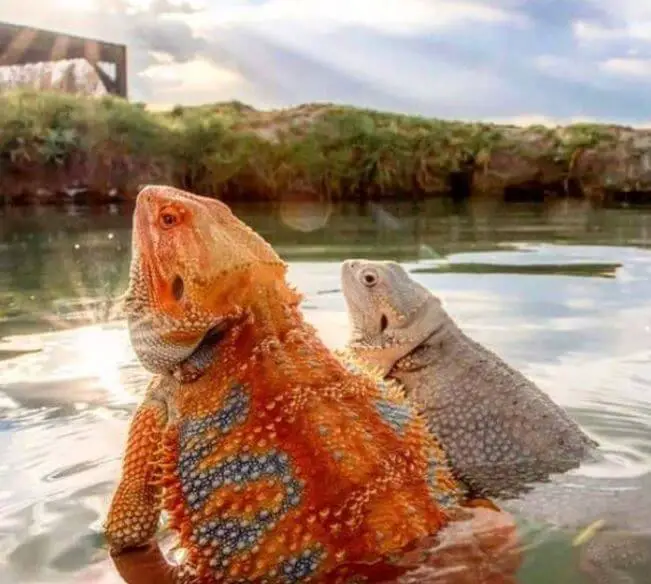
It is best if you let them go around in a strictly controlled area. Just make sure that the area is free from other animals like dogs, cats, or monkeys.
There are lots of people raising both monkeys and beardies and, trust me, they will not get along.
6. Do Bearded Dragons and Chameleons Love Music?
This all depends on their personality, just like humans.
If you want to share your favorite music with them, make sure that you play it in low volumes.
Avoid playing hard music such as metal rock or epic music.
Conclusion
Each species has its personality, so choosing between a bearded dragon VS chameleon will depend on what you like.
And just like having every pet in the world, you will have to pay lots of attention to them.
Things such as cages, diet, and living environment are also included.
Hope that throughout this writing, you will make the best decision in owning a reptile pet.
So, between bearded dragon VS chameleon, which one will win your heart?
Key points for bearded dragons vs chameleons:
Bearded dragons and chameleons are both fascinating reptile species that have become popular choices for pet owners. Each has unique characteristics, care requirements, and temperaments. Here’s a comparison of bearded dragons and chameleons to help you decide which might be the right fit for you:
Bearded Dragon (Pogona spp.):
1. Physical Characteristics:
- Bearded dragons are medium-sized lizards with flattened bodies, triangular heads, and a distinct “beard” of spiky scales under their throat, which they puff out to communicate or regulate body temperature.
- They come in various color morphs, including the classic tan or yellow with darker markings.
2. Temperament:
- Bearded dragons are known for their calm and friendly nature.
- They are generally more social and enjoy human interaction.
3. Lifespan:
- Bearded dragons have a relatively long lifespan, often living 10-15 years with proper care.
4. Diet:
- They are omnivores and have a varied diet that includes insects, leafy greens, and vegetables.
5. Habitat:
- Bearded dragons require an arid or semi-arid enclosure with basking spots, UVB lighting, and a temperature gradient.
6. Handling:
- They are comfortable with handling and can become quite tame with regular interaction.
Chameleon (Various species):
1. Physical Characteristics:
- Chameleons are known for their striking appearance, featuring prehensile tails, independently mobile eyes, and the ability to change color.
- They come in various species, each with unique characteristics and coloration.
2. Temperament:
- Chameleons are more solitary and less social compared to bearded dragons.
- They tend to be more reserved and may become stressed with excessive handling.
3. Lifespan:
- Chameleon lifespans vary by species but generally range from 5 to 10 years or more.
4. Diet:
- Chameleons are insectivores, primarily consuming a diet of live insects such as crickets, roaches, and flies.
5. Habitat:
- They require specific and well-maintained arboreal enclosures with high humidity levels, UVB lighting, and carefully monitored temperature.
6. Handling:
- Chameleons are best observed rather than frequently handled, as they are more sensitive to stress.
Considerations for Choosing Between Bearded Dragons and Chameleons:
- Temperament: Bearded dragons are more interactive and sociable, making them a good choice for those who want an engaging pet. Chameleons, on the other hand, are less social and prefer a hands-off approach.
- Habitat Setup: Bearded dragons require a more straightforward and spacious enclosure, while chameleons need specialized arboreal setups with controlled humidity.
- Feeding: Bearded dragons have a varied diet and are easier to feed, whereas chameleons can be more challenging due to their specific dietary needs.
- Handling: If you enjoy hands-on interaction, a bearded dragon may be a better choice. Chameleons are better for those who prefer observing their reptile without frequent handling.
- Appearance: Both have unique and attractive appearances, so your preference for a specific look can influence your choice.
Ultimately, the choice between a bearded dragon and a chameleon should consider your lifestyle, experience level, and personal preferences. Each has its charm, but their care requirements and temperaments differ, so it’s important to choose the reptile that best aligns with your expectations and abilities as a pet owner.
Further Reading:
- Carolina Custom Cages Terrarium Review
- 8 Best Basking Rocks for Beardie: What Is the Best Choice?
- 10 Best Thermometers for Beardie: How to Choose the Best One?
- 5 Best Beardie Lighting Setups for Beardie Lovers
- 9 Best Heat Lamps for Beardie: Natural Habitat Provided

